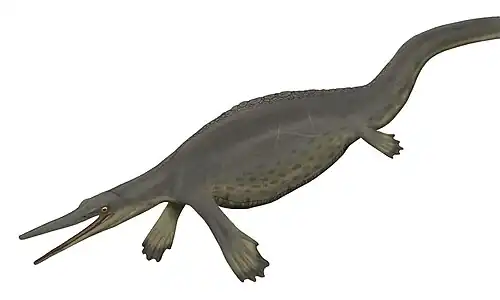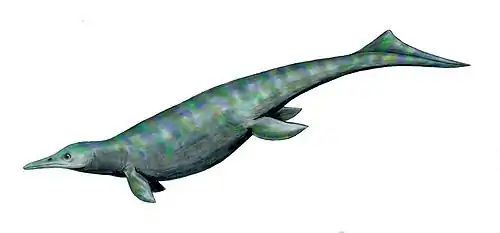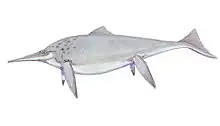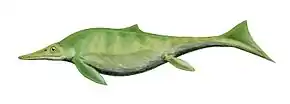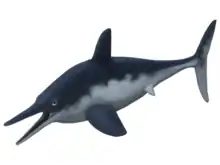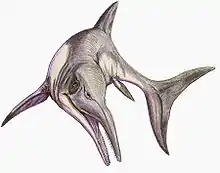Ichthyosaurus
Ichthyosaurus (derived from Greek ἰχθύς (ichthys) meaning 'fish' and σαῦρος (sauros) meaning 'lizard') is a genus of ichthyosaurs from the Early Jurassic (Hettangian - Pliensbachian[3]), with possible Late Triassic record,[1] from Europe (Belgium, England, Germany, Switzerland, and Portugal[4]). It is among the best known ichthyosaur genera, as it is the type genus of the order Ichthyosauria.[5][6][7]
| Ichthyosaurus Temporal range: Early Jurassic, Possible Late Triassic (Rhaetian) record, but yet to be confirmed[1] | |
|---|---|
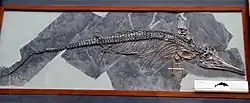 | |
| Fossil specimen of I. somersetensis at Natural History Museum, London | |
| Scientific classification | |
| Domain: | Eukaryota |
| Kingdom: | Animalia |
| Phylum: | Chordata |
| Class: | Reptilia |
| Order: | †Ichthyosauria |
| Family: | †Ichthyosauridae |
| Genus: | †Ichthyosaurus De la Beche & Conybeare, 1821 |
| Type species | |
| †Ichthyosaurus communis De la Beche & Conybeare, 1822 | |
| Other species | |
History of discovery
Ichthyosaurus was the first complete fossil to be discovered in the early 19th century by Mary Anning in England;[8] the holotype of I. communis, no coll. number given,[9] was a fairly complete specimen discovered by Mary and Joseph Anning around 1814 in Lyme Regis[10] but was reported as lost by McGowan (1974) in his review of the latipinnate ichthyosaurs of England.[11] The name Ichthyosaurus was first used by Charles König in 1818, but it was not used in a formal scientific description, with the earliest described ichthyosaur being Proteosaurus by James Everard Home in 1819 for a skeleton which is now attributed to Temnodontosaurus platyodon. Henry De la Beche and William Conybeare in 1821 considered Ichthyosaurus to have taxonomic priority over Proteosaurus and named the species I. communis based on BMNH 2149 (now NHMUK PV R1158), a now partially lost specimen now assigned to Temnodontosaurus that was discovered and collected between 1811 and 1812.[12][13] During the 19th century, almost all fossil ichthyosaurs were attributed to Ichthyosaurus, resulting in the genus having over 50 species by 1900. These species were subsequently moved to separate genera or synonymised with other species.[14]
I. anningae, described in 2015 from a fossil found in the early 1980s in Dorset, England, was named after Anning.[15][16][14] The fossil was acquired by Doncaster Museum and Art Gallery, where it was misidentified as a plaster cast. In 2008, Dean Lomax, from the University of Manchester, recognised it as genuine and worked with Judy Massare, of the State University of New York, to establish it as a new species.[15]
Description

Ichthyosaurus was smaller than most of its relatives, with the largest specimen of I. somersetensis measuring up to 3–3.3 m (9.8–10.8 ft) in length.[17] In comparison, other species were much smaller, with the I. communis reaching up to 2 metres (6.6 ft) in length, I. larkini probably up to 2.5 metres (8.2 ft), I. anningae up to 1.8 metres (5.9 ft), I. breviceps up to 1.9 metres (6.2 ft), and I. conybeari up to 1.5 metres (4.9 ft).[1][9] Many Ichthyosaurus fossils are well-preserved and fully articulated. Some fossils still had baby specimens inside them, indicating that Ichthyosaurus was viviparous. Similar finds in the related Stenopterygius also show this.[18][19] Jurassic ichthyosaurs had a fleshy dorsal fin on their back as well as a large caudal fin. Icthyosaurus is distinguished from other ichthyosaurs by having a wide forefin with 5 or more digits with an anterior digital bifurcation, but the morphology of the humerus and coracoids are also distinct from that of other Lower Jurassic ichthyosaurs, as is the arrangement of the dermal bones, though the suture lines used to diagnose these are not always visible.[14]
Classification
This cladogram below follows the topology from a 2010 analysis by Patrick S. Druckenmiller and Erin E. Maxwell.[20]
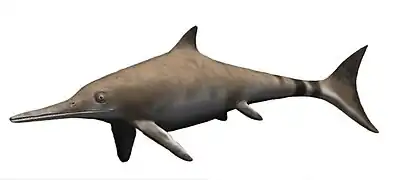
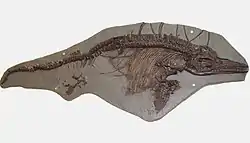
| Thunnosauria |
| ||||||||||||||||||||||||||||||||||||||||||||||||||||||||||||||||||||||||
Palaeobiology
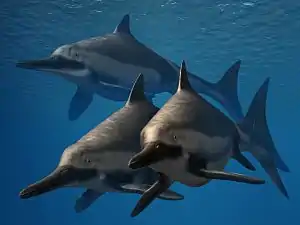
Ichthyosaurus ear bones were solid, probably transferring water vibrations to the inner ear. Even so, anatomical features demonstrate that it was a visually-oriented predator; it had huge, sensitive eyes, protected by bony shields. Coprolites of Ichthyosaurus reveal that its diet consisted of fish and squid.[22]
It was initially believed that Ichthyosaurus laid eggs on land, but fossil evidence shows that in fact the females gave birth to live young. As such, they were well-adapted to life as fully pelagic organisms (i.e. they never came onto land). The babies were born tail first to prevent them from drowning in the water.[18]
Cultural significance
_(21069255568)_(cropped).jpg.webp)
Joseph Victor von Scheffels poem Der Ichthyosaurus describes its extinction in humouristic verses. A monument on Hohentwiel cites it as well.[23] The poem has been translated among others by Charles Godfrey Leland[24] Some of the stanzas:
The rushes are strangely rustling,
The ocean uncannily gleams,
As with tears in his eyes down gushing,
An Ichthyosaurus swims.
He bewails the frightful corruption
Of his age, for an awful tone
Has lately been noticed by many
In the Lias formation shown.
...
The Plesiosaurus, the elder,
Goes roaring about on a spree;
The Pterodactylus even
Comes flying as drunk as can be.
The Iguanodon, the blackguard,
Deserves to be publicly hissed,
Since he lately in open daylight
The Ichthyosaura kissed.
The end of the world is coming,
Things can't go on long in this way;
The Lias formation can't stand it,
Is all that I've got to say!'
...
And this petrifideal ditty?
Who was it this song did write?
'Twas found as a fossil album leaf
Upon a coprolite.
References
- Lomax, D.R. (2019). "A revision of Ichthyosaurus (Reptilia, Ichthyosauria)" (PDF). The University of Manchester: Manchester eScholar. pp. 1–414. S2CID 210305170.
- Dean R. Lomax; Judy A. Massare (2017). "Two new species of Ichthyosaurus from the lowermost Jurassic (Hettangian) of Somerset, England". Papers in Palaeontology. 3: 1–20. doi:10.1002/spp2.1065. S2CID 89567182.
- Dean R. Lomax (2010). "An Ichthyosaurus (Reptilia, Ichthyosauria) with gastric contents from Charmouth, England: First report of the genus from the Pliensbachian". Paludicola. 8 (1): 22–36.
- Sousa, João; Mateus, Octávio (9 September 2021). "The southernmost occurrence of Ichthyosaurus from the Sinemurian of Portugal". Fossil Record. 24 (2): 287–294. doi:10.5194/fr-24-287-2021. ISSN 2193-0066. S2CID 239059696.
- Maisch MW, Matzke AT. 2000. The Ichthyosauria. Stuttgarter Beiträge zur Naturkunde, Serie B (Geologie und Paläontologie) 298: 1-159
- McGowan C, Motani R. 2003. Ichthyopterygia. – In: Sues, H.-D. (ed.): Handbook of Paleoherpetology, Part 8, Verlag Dr. Friedrich Pfeil, 175 pp., 101 figs., 19 plts; München
- Maisch MW, Reisdorf AG, Schlatter R, Wetzel A. 2008. A large skull of Ichthyosaurus (Reptilia: Ichthyosauria) from the Lower Sinemurian (Lower Jurassic) of Frick (NW Switzerland). Swiss Journal of Geosciences 101: 617-627.
- Essesials of Anthropology 6th addition
- Judy A. Massare & Dean R. Lomax (2018). A taxonomic reassessment of Ichthyosaurus communis and I. intermedius and a revised diagnosis for the genus, Journal of Systematic Palaeontology, 16:3, 263-277, DOI: 10.1080/14772019.2017.129111
- Home, E. (1814). Some account of the fossil remains of an animal more nearly allied to fishes than any other classes of animals. Philosophical Transactions of the Royal Society of London, 101, 571–577.
- McGowan, C. (1974). A revision of the latipinnate ichthyosaurs of the Lower Jurassic of England (Reptilia: Ichthyosauria). Life Science Contributions of the Royal Ontario Museum 100:1–30
- De la Beche, H. T. & W. D. Conybeare. (1821). Notice of the discovery of a new fossil animal, forming a link between the Ichthyosaurus and crocodile, together with general remarks on the osteology of the Ichthyosaurus. Transactions of the Geological Society of London 5: 559–594.
- Conybeare, W. D. (1822). Additional notices on the fossil genera Ichthyosaurus and Plesiosaurus. Transactions of the Geological Society of London, 1, 103–123.
- Lomax, Dean R.; Massare, Judy A. (2015). "A new species of Ichthyosaurusfrom the Lower Jurassic of West Dorset, England, U.K." Journal of Vertebrate Paleontology. 35 (2): e903260. Bibcode:2015JVPal..35E3260L. doi:10.1080/02724634.2014.903260. ISSN 0272-4634. S2CID 85745787.
- Gill, Victoria (19 February 2015). "BBC News - Forgotten fossil found to be new species of ichthyosaur". BBC Online. Retrieved 22 February 2015.
- "New species discovered in Doncaster". 19 February 2015. Archived from the original on 22 February 2015. Retrieved 22 February 2015.
- Lomax, D.R.; Sachs, S. (2017). "On the largest Ichthyosaurus: A new specimen of Ichthyosaurus somersetensis containing an embryo". Acta Palaeontologica Polonica. 62. doi:10.4202/app.00376.2017.
- Böttcher R. 1990. Neue Erkenntnisse über die Fortpflanzungsbiologie der Ichthyosaurier. Stuttgarter Beiträge zur Naturkunde, Serie B (Geologie und Paläontologie) 164: 1-51
- Martill D.M. 1993. Soupy Substrates: A Medium for the Exceptional Preservation of Ichthyosaurs of the Posidonia Shale (Lower Jurassic) of Germany. Kaupia - Darmstädter Beiträge zur Naturgeschichte 2: 77-97
- Druckenmiller, P. M.; Maxwell, E. E. (2010). "A new Lower Cretaceous (lower Albian) ichthyosaur genus from the Clearwater Formation, Alberta, Canada". Canadian Journal of Earth Sciences. 47 (8): 1037–1053. Bibcode:2010CaJES..47.1037D. doi:10.1139/E10-028.
- Arkhangel’sky, M. S., 1998, On the Ichthyosaurian Genus Platypterygius: Palaeontological Journal, v. 32, n. 6, p. 611-615.
- Palmer, D., ed. (1999). The Marshall Illustrated Encyclopedia of Dinosaurs and Prehistoric Animals. London: Marshall Editions. p. 80. ISBN 1-84028-152-9.
- Werkkatalog Sieckes (PDF; 7,7 MB)
- Charles Godfrey Leland, Gaudeamus! Humorous Poems by Joseph Viktor von Scheffel, Ebook-Nr. 35848 on gutenberg.org
